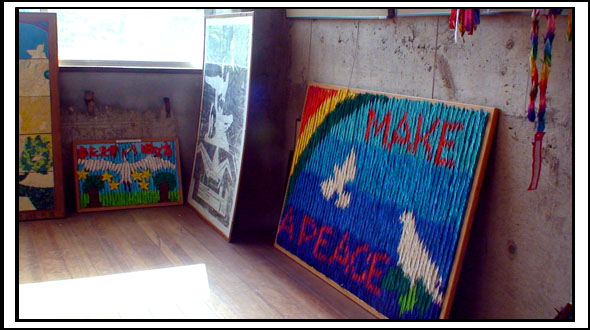..September 2008 Nagasaki..
“I realized that I must live on behalf of those who died unwillingly. I have to tell what happened, so they will not die in vain.”
Sumiteru Taniguchi-san
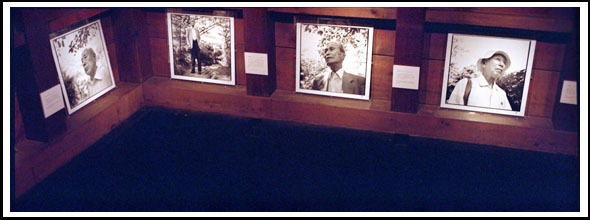
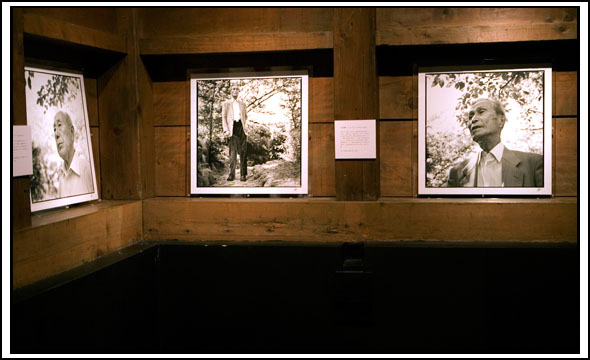
..September 2008 Nagasaki..
“I realized that I must live on behalf of those who died unwillingly. I have to tell what happened, so they will not die in vain.”
Sumiteru Taniguchi-san


..September 2008 Epicenter, Nagasaki..
Yamawaki-san was the 3rd portrait taken on my first day of photographing in Nagasaki. I photographed him at the atomic bomb epicenter close to the other locations I photographed the entire project. All of the portrait locations were taken within 300 feet of each other.
Yamawaki-san’s portrait was one of the more challenging portraits. He had a very serious demeanor. It wasn’t until seeing the print at the exhibition in Gallery EF did I see the softness in his eyes.
In the gallery, the serious tone on his face felt lighter and more reflective. A lot less tension in his face than in my original thoughts. His shoulders on the print were relaxed and softer around the edges.
What also felt different about his portrait and conversation was he was the only Hibakusha who spoke English. It brought a different dynamic to our friendship. Not that I felt more comfortable with him because we spoke the same language. I was very comfortable communicating in Japanese through a translator with everyone I met.
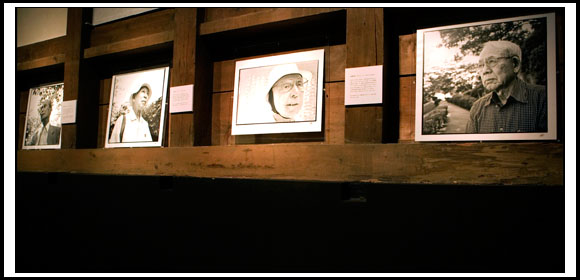
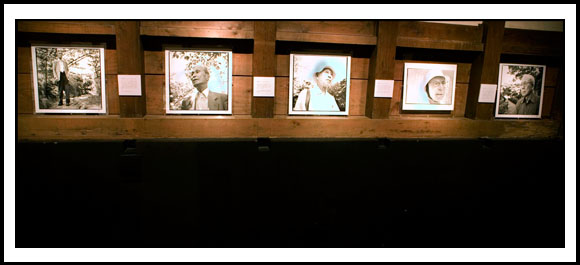
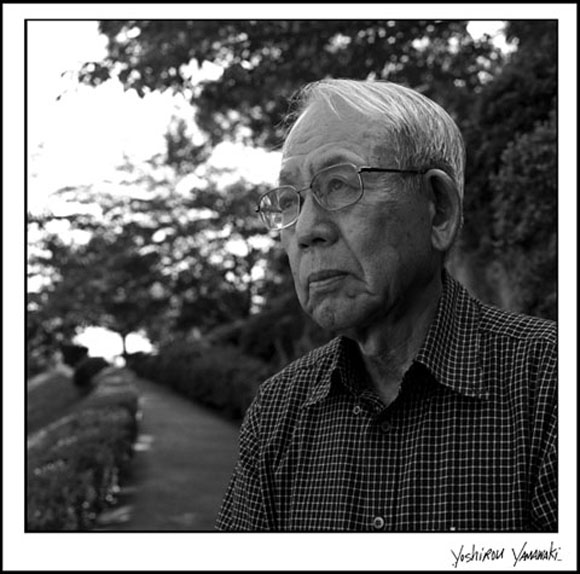
..September 2008 Nagasaki..
Map of Yamawaki-san’s journey to recover his father’s body the day after atomic bomb was dropped on Nagasaki.
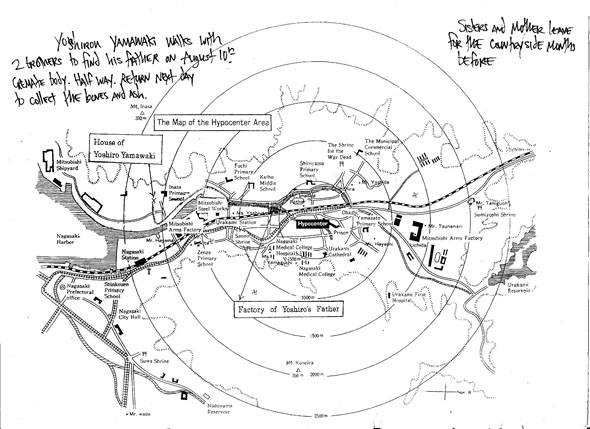
..September 2008 Nagasaki..
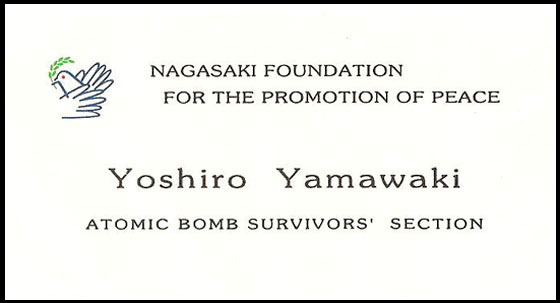

Yoshiro Yamawaki-san
74 years old
11:02AM August 9, 1945
Yamawaki-san’s story is about recovering his father’s body. He was 11 years old. Lived 2.2km from the epicenter. He and his brother where at home eating lunch at the time of the blast.
The atomic bomb blast tore apart the home. He remembers hearing the plane above. The surge of the blast. They could see the sky through the damaged ceiling beams. Nagasaki on fire and destroyed.
They waiting all night for their father to return from the Mitsubishi Steelworks factory located near the epicenter, 500 meters. He never returned. They assumed he would return home.
The next morning, August 10th, 1945, he and his brother decide to walk to the factory. The factory was located on the Urakami River. Very close to the building I was now sitting in 64 years later. I could see the former location over Yamawaki-san’s shoulder through the large window at the end of the room.
As they walked closer to the factory the devastation grew worse. They had to step easily to avoid breaking the heaps of bodies lying on what used to be streets along the river. Swollen dead bodies and scorched debris.
“…Those who died were swollen like black rubber dolls and their skin peeled off when touch even slightly.” -Mr. Yamawaki
They froze at the site of the Mitsubishi Steelworks factory. Almost nothing was left. At the factory, they found a worker who knew where their father’s body was. The 2 young boys collected wood to cremate their father’s body. They set the fire.
“…My brother and I collected pieces of wood, which we used to cremate our father’s body. When we saw the flames licking up his feet, we couldn’t stop the tears from flowing…..” -Mr. Yamawaki
They returned the next day to find the body wasn’t fully cremated. Only his hands and feet were burnt to the bones. Saddened they have not told their now 92 year old mother the story. They never will.
Mr. Yamawaki was the only Survivor to tell his story in English. I was surprised, when asked why he learned English in his late 60’s. He had retired and found it necessary to continue learning. It’s another display of the spirit of the Hibakusha I met in Nagasaki. Their will to want to live and go beyond.

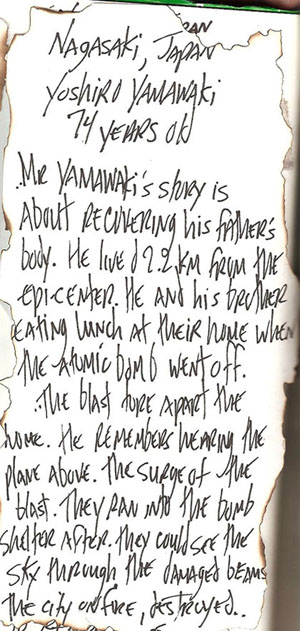
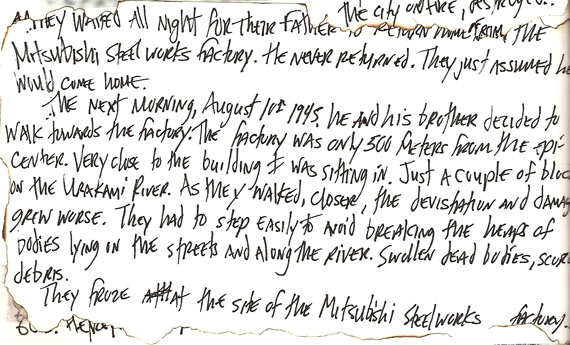
..March 2009 Gallery EF, Asakusa, Tokyo..
Interview for Tokyo Art Beat about From Above portrait exhibition, Nagasaki atomic bomb Survivors and Tokyo fire bombing Survivors.
Published in March 2008 while the exhibition was shown at Gallery EF in Asakusa, Tokyo.
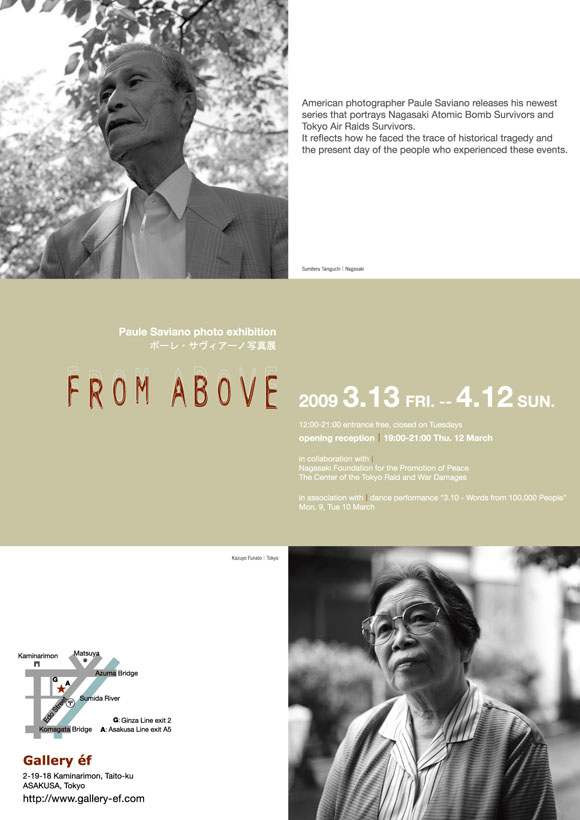

..September 2008 On the train staring out the window..
Somewhere on Kyushu Island. 7 hours from Tokyo. 2 hours from Nagasaki.
It’s a slow ride once in Kyushu. A local train snakes through hills and around a narrow rocky coast line. I’m a million thoughts away from the neon signs and brazen electricity of Tokyo.
Farms, lush green pastures, windmills, and old buildings line the country side. Could be a scene from The Sound of Music. Monet would have painted these landscapes. Green water colors and blue-ish sky smirred with white clouds.
I imagine life to be simple here. Slow, no urgency to get from one place to another.
How could the peaceful scenery I now look at, be the background for history’s darkest moment. It is here, in the middle of a tranquil nowhere, the eyes of the world looked upon. This peaceful sunshine was swallowed whole by a mushroom cloud. How could it have shined on such a dark time.
The colors and light I’m staring at don’t mix with war, death, destruction, xenophobia, genocide, and rains of fire. Smoke must have billowed from these hills, smothered the blue sky with choking gray.
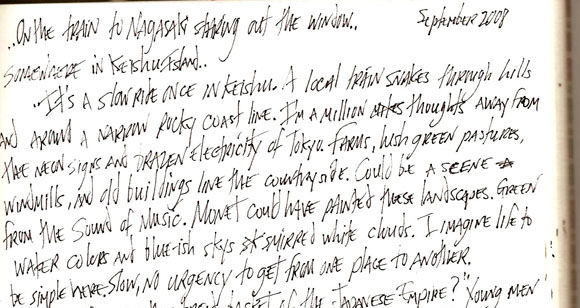
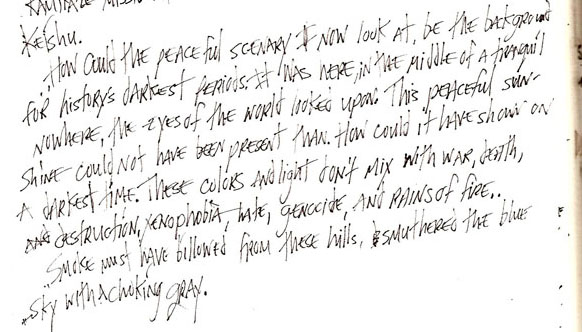
..September 2008 New York to Tokyo, Heading to Nagasaki..
From Above
Emotions, layered on top of emotion. That’s what I want in these portraits . Not just photos of 70-80 year old men and women.
I hope they let me in. Give me an emotion to photograph. I have to make them trust me. I want to concentrate on the eyes. The emotions are in the eyes. This could be a very mediciore. If the emotion is there. It will be a successful experience.
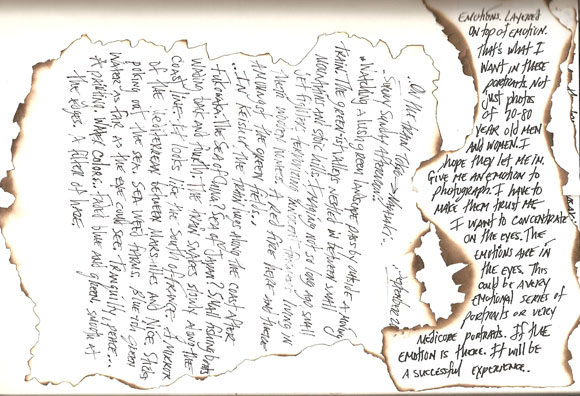
..September 2008 Epicenter, Nagasaki..
..The park is dark except for the illuminated gas lanterns circling the edge of the paths. I only hear chirping birds and grasshoppers whisper.
A short walk to the monument. Put the palm of my hands on the marble box shaped monument in memory of victims, many who were vaporized. Look up. It’s as if there is always a light shining From Above on the very spot. A straight beam like the vacuum a mushroom cloud. But it’s not there in reality.
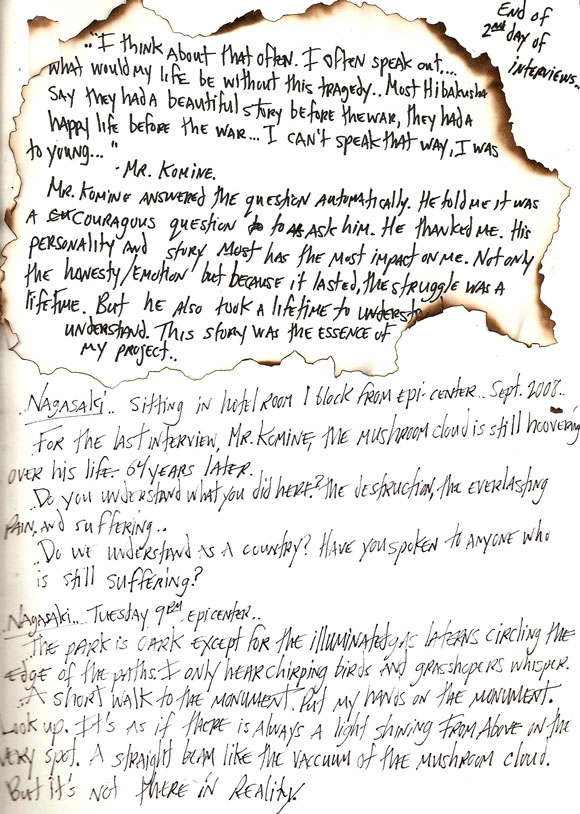
..September 2008 On the train Tokyo to Nagasaki..
A sunny Sunday afternoon.
Watch a lush green landscape pass by outside a moving train. The rich valleys nestled between small mountains and stoic hills. Imaging not so long ago, bombers and attack planes terrorizing the people living in their wooden houses. A red fire here and there among the green fields.
In Keishu the train hugs along the coast after Fukowaka. Small fishing boats wading back and forth. The train slowly snakes along the coast line. It looks like the South of France. A mirror of the Mediterranean Sea between Marseille and Nice.
Sticks poking out of the sea. Sea weed farms. Blue-ish green water as far as I can see. Tranquility and peace….a painting. Water colors…Faded blue and green smooth at the Edges. A filter of haze.
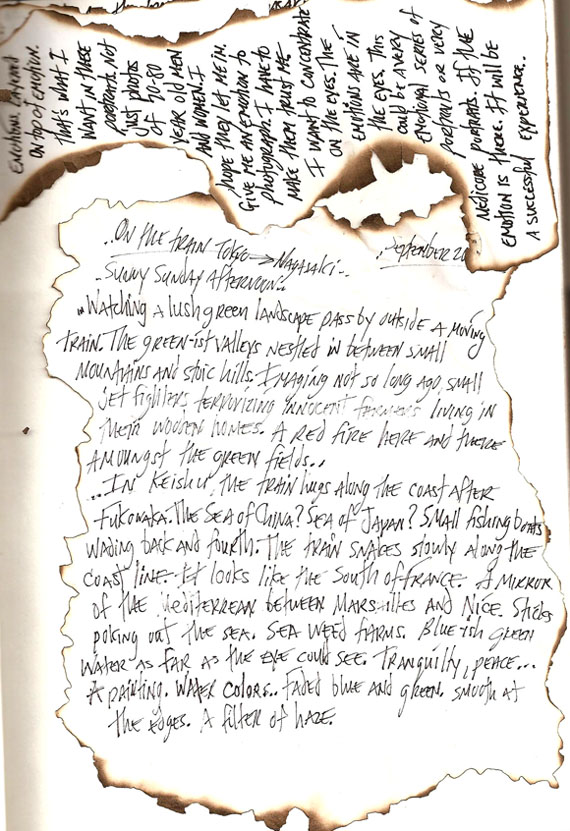
..September 2008 Nagasaki..
3 days in Nagasaki. Not many foreigners wandering around. Haven’t wandered to far away from the epicenter area. 15 minute walks in different directions. Still a lot of history visible. More history if you ask people to tell you their story.
Took a 10 minute walk. Crossed the river to the Shiroyama Elementary School. Located 500 meters from the epicenter. It’s a concrete building that was almost completely destroyed. But it’s one of a small handful of structures that had something left. It was reinforced after the reconstruction.
Walked through the damp cement classrooms. It serves as a museum/art exhibition. Rooms full of paper cranes and old photographs of the building before and after.
29 teachers and 110 students were killed instantly at the site. 1,400 school children, who were at their homes at the time of the bombing 11:02AM, were also killed. It’s a school but also a sacred ground for the children who perished here. It was there final resting place.
I thought about the children who once inhabited these rooms. They were attending school like any normal day. Innocent children.
….The present students in the classrooms at the new school built 50 feet from the Surviving building. How do you understand the story of what happened here when your that young? I don’t know if it’s possible until you’ve grown older.
This is the reality many don’t understand unless they take a trip to Nagasaki and speak to people.
We walked around the grounds. The school is perched on the side of a steep hill. The entrance looks like the opening of an orchard. Buildings hidden behind a wall of thick green foliage basking in the long hot humid Nagasaki summer.
Walked past an auditorium filled with young students. A type of assembly. Walked around a soccer field with swings. Imaged empty swings 64 years ago.
The same scene could have been occurring on August 9th, 1945 as today. An ordinary school morning. Children sitting in an auditorium not knowing what would happen. Never thinking they wouldn’t live another morning or be able to say goodbye. Children. It’s important to understand what has happened here.
